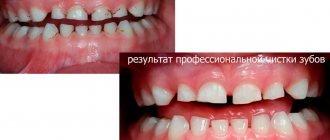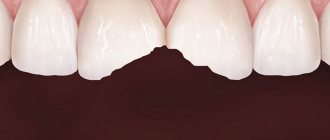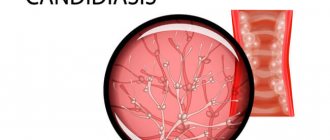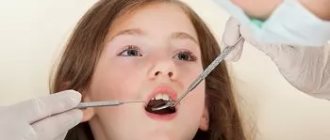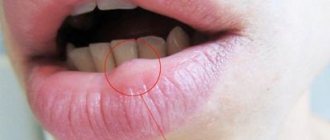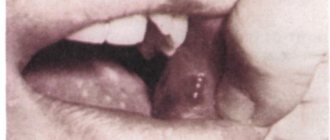How does coffee affect enamel?
If you doubt whether coffee makes teeth yellow, look at the structure of the tooth. The enamel has pores where microparticles of coffee grounds penetrate. Because of this, dark spots appear. But some people have a smooth surface on their teeth. No staining deposits settle on their enamel and they can drink their favorite drink without harm.
Plaque on teeth from coffee is not only an external problem. As it accumulates, it begins to harden and turns into tartar. And this already leads to the appearance of periodontitis.
How is plaque formed?
First, soft plaque forms on the teeth, the formation of which consists of three stages:
- A couple of minutes after the end of cleaning the oral cavity, active reproduction and spread of bacteria throughout the oral cavity begins. The process takes 4 hours, after which the number of bacteria reaches a million.
- Over the next 3 hours, the bacteria attach to the surface of the tooth enamel and form a soft film. After fixation, microorganisms begin to release substances that destroy the enamel, causing carious lesions to develop.
- When 8 hours have passed after cleansing the oral cavity, deposits become visible and structured. The majority of bacteria in them do not require oxygen.
The resulting film progressively thickens and becomes denser. hard plaque forms within a day after the last brushing. The formation of tartar is typical for surfaces that have little contact with the tongue and food.
Causes of yellowness
Naturally, a small amount of coffee drink is not harmful to teeth. Natural dye is only dangerous for people who use it regularly.
In addition to the dye, the formation of stains after coffee drinks is affected by:
- Temperature. Drinking coffee hot is harmful. The pores expand and the coloring matter easily penetrates the enamel. The spots appear faster.
- Destructive acids that make up Arabica. There are more of them in this variety than in Robusta. Therefore, Arabica beans make teeth darken faster.
- Contrasting temperatures increase the risk of yellow discoloration. Therefore, in cold weather, do not drink coffee outdoors. And even more so in the cold. It is better to refuse a cocktail made from coffee with ice cream. This combination quickly destroys the tooth surface and makes it easier for the coloring matter to seep inside.
- Food residues on the teeth absorb and retain coffee particles. It turns out like a coloring lotion. If you don't take care of your mouth and don't brush your teeth well, they will turn yellow or dark.
As you can see, there are many reasons for yellowing. Coffee lovers should be more careful about hygiene.
Can tint appear due to coffee with milk?
Some people add milk to the smoothie and believe that this way they reduce the effect of coffee on tooth enamel. There is a grain of truth in this.
Scientists conducted an experiment. They placed the extracted teeth in two containers. One had black espresso, the other coffee with milk. In black coffee, the tooth darkened, but in a drink without milk, the color did not change. This means that milk neutralizes the harmful effects of the dye.
But the ratio of components also affects. Too strong coffee with milk in small quantities harms your teeth more than a weak drink without milk.
Another reason to add milk is calcium, which is necessary for the strength of the tooth surface. The lack of substance also affects the appearance of the shade. Therefore, it is better for coffee lovers to choose between latte and cappuccino, and not overuse espresso.
What is more harmful: coffee or tea?
There is an opinion that tea is less harmful than a coffee cocktail. In fact, both drinks contain about the same amount of caffeine. This is discussed in detail in the article “Where is there actually more caffeine: in coffee or tea? Let's count."
From this we can conclude that the coloring effect of coffee and tea will be the same. The latter will also intensify if, after drinking, you rinse your mouth with preparations containing chlorhexidine.
Prevention
Compliance with preventive standards can reduce the risk of developing any dental disorders, including the formation of gray plaque.
For prevention purposes, the following rules should be followed:
- Timely brushing of teeth
- Refusal of coloring products (tea, coffee, alcohol, sweet drinks)
- Regular visits to the dentist
- Reducing the amount of carbohydrates consumed
- Prevent dry mouth
- Using rinse aids
- Using sugar-free chewing gum
Gray plaque is one of the most common dental problems caused by poor hygiene. To eliminate this violation, you should contact a dental clinic, where the contamination is removed through professional cleaning.
Is it possible to drink coffee after brushing and whitening your teeth?
We are sometimes asked how long after brushing our teeth we can start drinking coffee. But it all depends on what kind of cleaning you have in mind. After all, we can talk about a daily hygiene procedure or professional whitening from a specialist.
If you just brushed your teeth, you can drink coffee right away. Just remember to brush them at least twice a day and you'll be fine.
But to protect yourself from plaque after professional cleaning, refrain from drinking the drink for at least a day. For the second course you can drink a little latte. Then you can return to your normal routine.
Gray plaque on baby teeth
Gray plaque is often found on children's baby teeth.
In most cases, the occurrence of such a disorder is not associated with pathological processes, and is a consequence of poor hygiene. Possible causes include:
- Inadequate teeth cleaning
- Initial stage of caries
- Dental hypoplasia
- Oral dysbiosis
If a gray coating is detected in a child’s mouth, it is recommended to seek medical help. This can significantly reduce the risk of possible complications. In most cases, improving the quality of daily hygiene is enough to eliminate the problem.
Coffee and healing procedures
After filling or implants, there are usually no restrictions on drinking espresso, but be sure to consult with your doctor.
Interesting! Can coffee make you fat?
But keep in mind that the filling material may be stained. Especially at first. Therefore, it is better to refrain from pure coffee. It is better to add milk during the day.
After tooth extraction, you can drink coffee within a few hours. But it is important to remember that it must be warm.
But before removal, drinking the drink is prohibited. This is due to the fact that caffeine weakens the effect of anesthesia.
Prices for procedures
The cost of plaque removal depends on many factors.
These include:
- Cleaning or bleaching method used
- Number of teeth processed
- Qualification of the attending dentist
- Materials and equipment used
It is also necessary to take into account that in addition to direct cleaning, the patient is provided with consultations, dental examinations are performed, and for some procedures, radiography is performed. In turn, this may affect the overall cost of treatment.
The approximate cost of procedures for removing gray plaque is:
- Intra-canal whitening (endo-bleaching) – from 1500 rubles. for 1 tooth
- Mechanical cleaning – from 1200 rub.
- Ultrasonic cleaning – from 70 rub. for 1 tooth
- Removing plaque using the Air Flow procedure – from 4,500 rubles. (for 2 jaws)
- Laser whitening – from 6,000 rubles.
How to drink correctly
There are several important tips on how to drink coffee to prevent your teeth from yellowing:
- drink only Americano or add milk or cream to the drink;
- Before drinking espresso, let it cool, hot water damages the enamel.
- after drinking any coffee drink, rinse your mouth with special rinses or at least warm water;
- Use professional products to clean your teeth.
These simple rules will reduce the harm of the coloring pigment.
How to remove coffee stains from teeth
Folk remedies
If stains have already appeared, there are several ways to deal with them or at least reduce the shade.
The following methods will help reduce the effect of coffee on your teeth.
Using a cotton pad or brush, rub baking soda into the enamel. Then rinse your mouth with plenty of warm water.
Grind the activated carbon tablet to a powder. Then brush your teeth and rinse your mouth thoroughly.
Hydrogen peroxide does an excellent job of removing plaque and yellowness. But be careful. The product can damage the enamel. At the first suspicion of a problem, use of peroxide should be stopped. You need to use the product to remove stains for at least two weeks. To do this, moisten a cotton pad with it and thoroughly wipe the teeth.
It is useful to use apple, lemon peel or strawberry for stains. First, you need to rub the crushed fruit on your teeth, and then brush them with a toothpaste containing fluoride. This method can be used no more than twice a month. Otherwise, the acids contained in fruits will damage tooth enamel.
Despite the benefits and apparent safety of folk remedies, you should be careful when using them. Therefore, before starting treatment, it is necessary to consult a doctor.
Interesting! How many cups of coffee can you drink per day?
Pharmacy products
Medicines purchased at the pharmacy will also help to cope with yellowness.
Use a paste with a whitening effect in combination with a brush with stiff bristles.
An electric brush can easily remove plaque that has recently appeared. The device works faster than manual cleaning, and therefore quickly eliminates the problem. Pay attention to the stubble. It shouldn't be too hard. Otherwise, you can damage the enamel and gums.
Whitening strips are used for at least two weeks. They are glued to problem areas of the enamel and kept for about 30 minutes. The downside of the product is its high cost.
Gels with a whitening effect are considered effective and at the same time safe ways to cope with yellowness. Before applying the gel, your teeth must be thoroughly cleaned. Apply a small amount of product to a clean surface. Then you should wait until the drug dissolves. The procedure is repeated for two weeks.
The sticks gently and carefully whiten the enamel. But they are used to prevent plaque, and not to fight it. Therefore, they should be used immediately after drinking espresso.
Whitening trays are effective in fighting stains. They can even handle old yellow stains. It is necessary to use the method strictly following the instructions for use. Overuse of mouthguards destroys enamel.
You can remove plaque at home only after consulting a doctor.
He will be able to advise you on the best method to suit your teeth specifically.
Tooth discoloration: causes and treatment methods
04.10.2012 14:43- ZOOM4 whitening (+ comprehensive hygiene + set for home whitening and remedial therapy) — 30,000 rub
Causes of tooth discoloration
Discoloration of teeth can occur both from the surface of the teeth and from the pulp cavity. Tooth discoloration is conventionally divided into external (located on the surface of the tooth) and internal (located in the thickness of the tooth). External color changes can become internal over time.
- Widespread superficial staining of teeth with vital pulp is the result of consuming beverages or foods containing high levels of dyes. Tobacco causes a yellow-brown or dark discoloration, usually in the isthmus of the teeth and mainly on the lingual surfaces. When chewed, tobacco quickly penetrates the enamel and forms even darker stains, while marijuana can produce clear rings in the cervical part of the teeth near the gum line. Coffee and tea cause the formation of pronounced and persistent brown or black stains on tooth enamel.
- Internal staining can be caused by medications such as tetracycline. Teeth are most sensitive to tetracycline staining during the period of formation, i.e., from the second trimester of pregnancy until approximately 8 years of age. It is believed that tetracycline molecules are absorbed by dentin during the mineralization of teeth. If tetracycline-stained teeth are exposed to sunlight, they will gradually turn dark gray or brown. Since tetracycline is absorbed by dentin during the period of mineralization of the buds, adults whose teeth have already formed can use antibiotics without the risk of tooth discoloration. However, a semi-synthetic tetracycline derivative used to treat acne has recently been found to cause tooth staining in adolescents. It is believed that tooth pigmentation occurs due to the ability of minocycline to form chelates with iron and create insoluble complexes.
- In areas where drinking water contains large amounts of fluoride, children during the period of enamel development and mineralization of tooth germs can absorb excess amounts of fluoride, which causes disruption of ameloblast metabolism, leading to the formation of a defective matrix and improper mineralization - endemic enamel fluorosis. There are two types of dental damage caused by fluorosis: discoloration and surface defects. Affected teeth usually have a shiny surface and may be papery white with areas of yellow or brown (sometimes black) discoloration.
- Fillings and restorations also often cause discoloration of teeth. Destructuring of tooth-colored restorative materials, such as acrylics, glass ionomer cements, or composites, causes the tooth to appear gray or less saturated over time. Metal fillings and inlays made of amalgam, alloys of silver and gold, can be visible through the enamel.
- Oils, iodine compounds, nitrates, root canal filling materials, pins and other materials used in restoration can also cause tooth discoloration. The degree of staining of teeth is determined by the length of time during which these substances penetrated into the dentinal tubules.
- Teeth staining can also occur due to systemic diseases. Although there are many genetic or childhood diseases that change the color of teeth, most are rare.
Examples of such conditions are:
- Green-blue or brown discoloration of primary teeth, observed in children who suffered hemolytic jaundice in infancy. These stains are the result of postnatal staining of dentin with bilirubin and biliverdin.
- A characteristic brown staining of teeth caused by the destruction of a large number of red blood cells during erythroblastosis fetalis as a consequence of the incompatibility of Rh factors of the fetal matter.
- Red-brown discoloration of teeth in people suffering from porphyria, a very rare disease in which an excess amount of pigment is produced.
- Changes in the color, shape and structure of teeth almost inevitably occur as we age. The nature and extent of such changes depend on a combination of genetic factors, lifestyle and various bad habits. Years of smoking and drinking coffee have a cumulative staining effect. These and other types of plaque become even more noticeable due to the inevitable formation of cracks and other changes in the surface of the teeth within their crystalline structure, in the underlying dentin and pulp. In addition to abrasion and injury to teeth, old amalgam fillings and other restorations may begin to deteriorate. Even with a very careful approach to these problems, teeth will change color with age due to natural wear, as well as as a result of exposure to the oral environment. Initially, thinning of the enamel usually occurs. In this case, the buccal surface of the tooth becomes flatter and due to the loss of the transparent enamel layer, a gradual change in the color of the tooth occurs. When the enamel becomes thinner, a natural defense mechanism in the dentin and pulp begins the process of forming secondary dentin. This increased mass of dentin begins to darken. Thin enamel combined with darkened dentin gives teeth an “older” appearance.
- White spots, symmetrically located on the teeth of the same name, may be a symptom of enamel hypoplasia. One of the features of hypoplasia spots is that they are not stained with dyes, and the outer layer of enamel remains smooth and shiny. Chalky teeth can be a result of excessive whitening and prolonged use of soda for this purpose. Small chalky stripes - streaks located in the subsurface layers of the enamel are characteristic of the streaked form of fluorosis. The spotted form of fluorosis is characterized by the presence of chalky spots without stripes. The chalky-mottled form of fluorosis is distinguished by significant diversity. Typically, tooth enamel has a matte tint, and against this background pigmented spots with clear boundaries are visible. Sometimes a large number of spots and dots are found on the enamel. A pronounced whitish color may be due to dense plaque formed as a result of insufficient or improper individual oral hygiene.
- Depulped teeth lose their characteristic shine and acquire a more grayish tint. A similar, and sometimes more intense, color change is observed in teeth with pulp necrosis. Gray coloration can also be caused by poisoning with heavy metals - mercury and lead.
- Teeth with a greenish tint appear when their surface is damaged by specific fungi. Green staining can occur when a tooth comes into contact with copper amalgam fillings. Yellow teeth can be a result of exposure to bromine and iodine fumes, as well as constant consumption of strong tea and coffee. A dark brown border often appears in smokers. Dark brown (even black) color of teeth can appear due to professional contact with metals (manganese, iron, nickel). A change in the color of the tooth crown can occur immediately after an injury, especially in the cervical area on the palatal side, where the enamel layer is thinner, which is a diagnostic sign of injury. Thus, tooth discoloration clinically manifests itself in a wide variety of shades.
Teeth whitening
Changing the color and brightness of teeth is one of the most frequently requested procedures by patients from the dentist today. Geographically, all modern teeth whitening technologies originate from the United States of America.
At different times and different peoples had their own idea of beauty. And what one culture perceives as beautiful, another may consider ugly. For example, in Japan, more than 4 thousand years ago, there was a tradition of decorative staining of teeth. This procedure was considered cosmetic, and its main result was to give the enamel of the teeth a dark brown color.
Harmony of color, together with integrity, symmetry and proportionality, is the basic criterion for aesthetics in composition. Therefore, patients believe that among the factors influencing the attractiveness of a smile, the color of the teeth is the most important. The demand for cosmetic services has increased dramatically in recent years everywhere.
It is necessary to distinguish between the concepts of teeth whitening and teeth whitening.
→ Teeth whitening
This is the return of their natural color due to the mechanical removal of surface pigment deposits. Teeth whitening occurs due to the removal of supra- and subgingival dental plaque with ultrasound. Removing dental plaque using the Airflow device. Polishing teeth with brushes with special abrasive pastes. These manipulations will lighten your teeth to the natural color given to you by nature.
→ Whitening
- this is already a change in the shade of the tooth due to the release of atomic oxygen, which penetrates the enamel and dentin of the tooth and breaks down the pigment. There are several methods of teeth whitening. All professional whitening methods are divided into clinical (the procedure is performed by a dentist in a dental office) and home (the patient independently uses trays with whitening gel at home). Clinical whitening systems come with light and chemical activators. Traditionally, hydrogen peroxide is used in clinical systems - 25 -38%. Such systems can whiten teeth up to 15 shades. Home systems contain lower percentages of hydrogen peroxide up to 10%. The effectiveness of home whitening is significantly lower - from 1 to 8 tones. As for the agents that form the basis of any bleaching system, nothing fundamentally has changed since 1884, when Harlan first proposed the use of hydrogen peroxide. The advantage of professional whitening is that the procedure is carried out and supervised by a doctor.
Indications for teeth whitening
- The patient's desire to make his teeth lighter.
- Mild and moderate form of fluorosis.
- Age-related changes in tooth color (yellowing).
- Coloring as a result of bad habits.
- Penetrating staining from frequent consumption of coloring foods and drinks.
Contraindications
Are common
- Patient's age (minor children and adolescents).
- Pregnancy and breastfeeding.
- Allergic reactions to whitening components.
- Taking light-sensitive drugs such as doxycycline, tretinoin, ciprovloxacin, hydrochlorothioside, etc.
- General diseases: cancer and endocrine diseases, bronchial asthma, hypertension.
- Inflated patient expectations from the whitening procedure.
Local
- The presence of carious cavities, fillings, restorations, crowns in the whitening area.
- Wide pulp chamber.
- Enamel hyperesthesia (increased sensitivity of teeth).
- Significant loss of enamel as a result of pathology and age.
- Acute and aggravated periodontal diseases.
- Diseases of the oral mucosa.
- Diseases of the temporomandibular joint accompanied by limited mouth opening.
- The patient has a pronounced gag reflex.
Possible complications
- The appearance of hyperesthesia (can last from several hours to several days). To eliminate it, it is necessary to conduct a course of retherapy before and after the whitening procedure. The use of desincitizers, special rinses and toothpastes for sensitive teeth.
- Irritation of the oral mucosa (burning).
- Color regression. Within 2 weeks after the whitening procedure, the oxidation process causes a change in the optical qualities of the tooth, giving it a more opaque appearance. After 2 weeks, the oxygen dissipates and the tooth acquires a real light shade.
- Change in taste sensations. It is temporary.
To maintain the results obtained, the patient must follow the following recommendations:
- Follow the rules of personal oral hygiene every day.
- In the first 48 hours after the whitening procedure, do not eat foods with coloring, and in the next 2 weeks follow a clear diet.
- Visit the dentist regularly at least once every six months.
- Repeated course of whitening after 1.5-2 years (if necessary).
Scheme of the teeth whitening procedure
- Questioning
- History taking
- Determining the cause of dental discoloration
- Availability of indications and contraindications.
- Discussion of complications and side effects after the teeth whitening procedure.
- Discussion of patient behavior after a whitening course.
- Registration of the patient's informed voluntary consent to the whitening procedure.
- Determination of the initial color of teeth is carried out using the Vita scale + photographs.
- Professional oral hygiene.
- Applying a protective gel to the mucous membrane.
- Applying whitening gel to teeth (3 sessions of 15 minutes each)
- Registration of the results obtained (color according to the Vita scale + photographs, presence of complications)
- Carrying out a course of remediation after the whitening procedure.
- Recommendations after the whitening procedure, individual selection of oral hygiene products, setting a date for re-examination.
- Re-inspection. Determining the need for a repeat course of whitening. To maintain stable results, prescribe home teeth whitening products (if necessary)
- Repeated whitening procedure (if necessary).
Toothpastes with whitening effect
Patients often ask: is it enough to use whitening toothpaste to whiten teeth?
The main purpose of whitening toothpastes is to maintain the results achieved by professional whitening.
Whitening components included in toothpastes:
- Substances that dissolve plaque (proteolytic enzymes: bromelain, papain)
- Substances with enhanced cleaning properties (sodium bicarbonate)
- Substances that suppress plaque formation (xylitol, bromelain, triclosan with copolymer)
- Substances that inhibit plaque mineralization (pyrophosphates, zinc citrate)
When deciding to use toothpastes with a whitening effect, you need to consider a number of points: Toothpastes based on polishing abrasives are widely available on the market. Constant use of such pastes leads to abrasion of tooth enamel, so such pastes are not recommended for regular use. You can choose different modes of their use. But such pastes are absolutely not suitable for people with cervical dental defects.
Sometimes toothpaste manufacturers promise to lighten teeth by several shades. This effect is achieved using toothpaste that contains carbamide peroxide, as well as home whitening systems. In this case, the concentration of carbamide peroxide should be 8-10 percent. The main distinguishing feature of this toothpaste is its specific peroxide taste. These pastes are technologically very difficult to produce, so there are only a few offers on the market.
